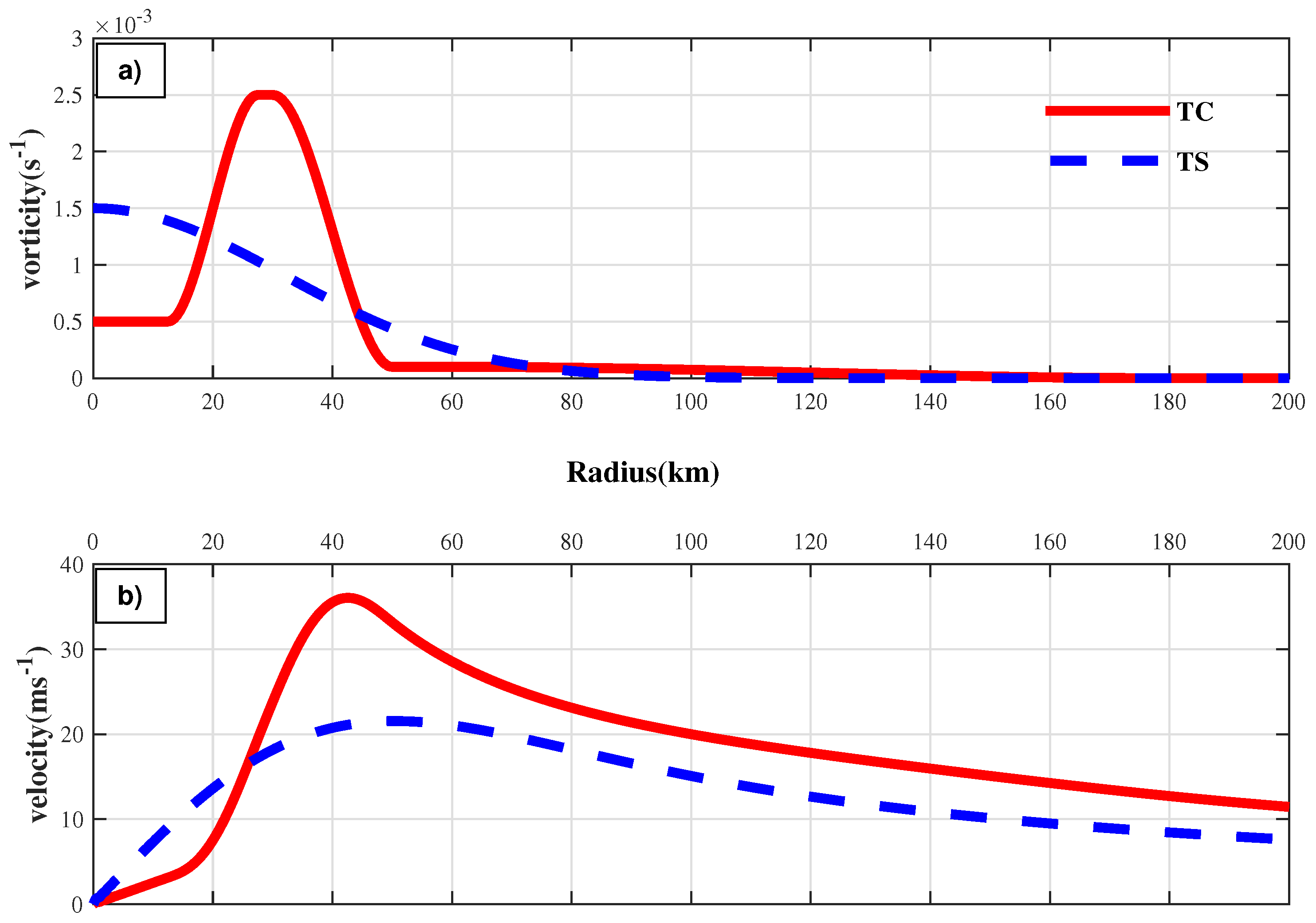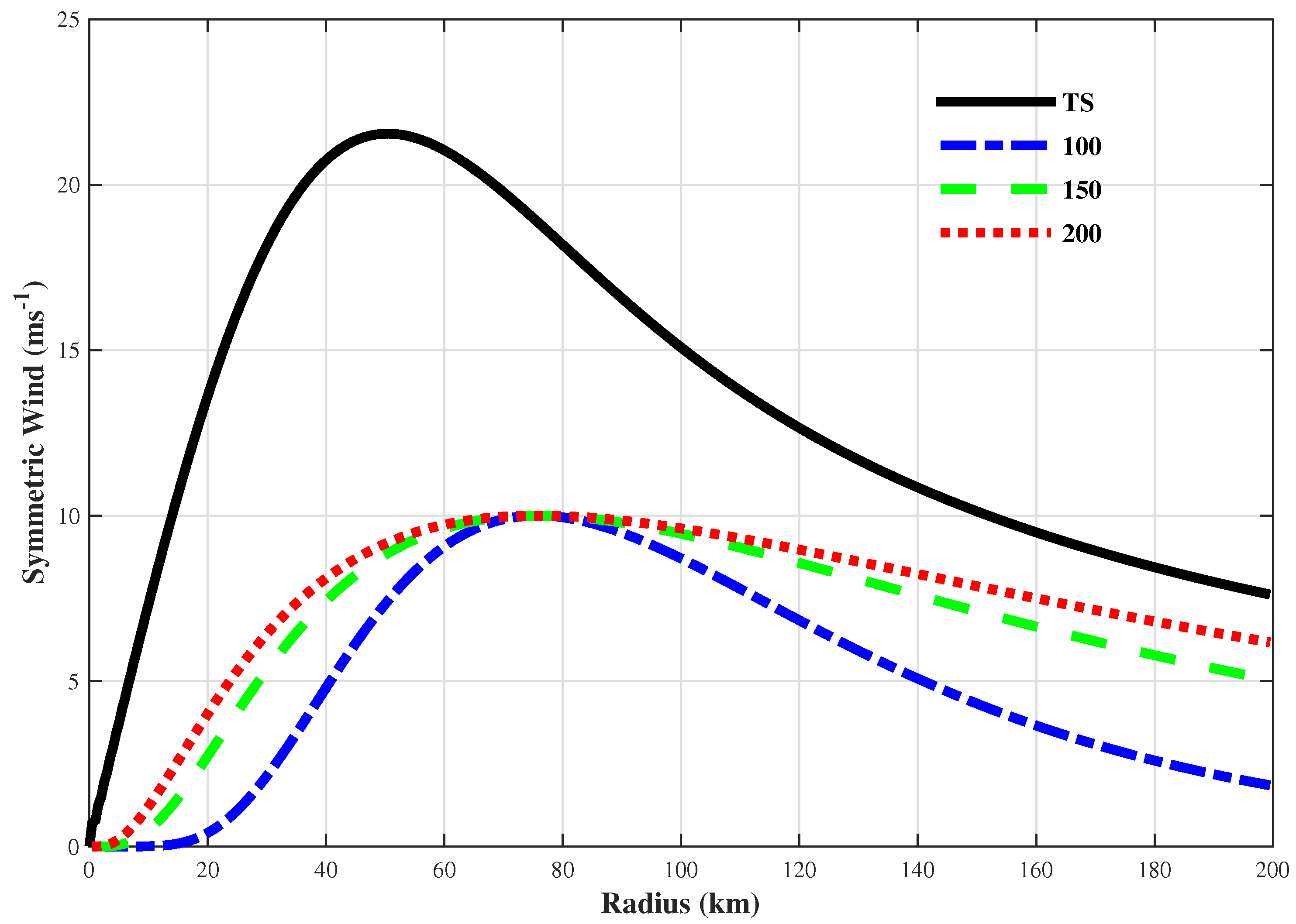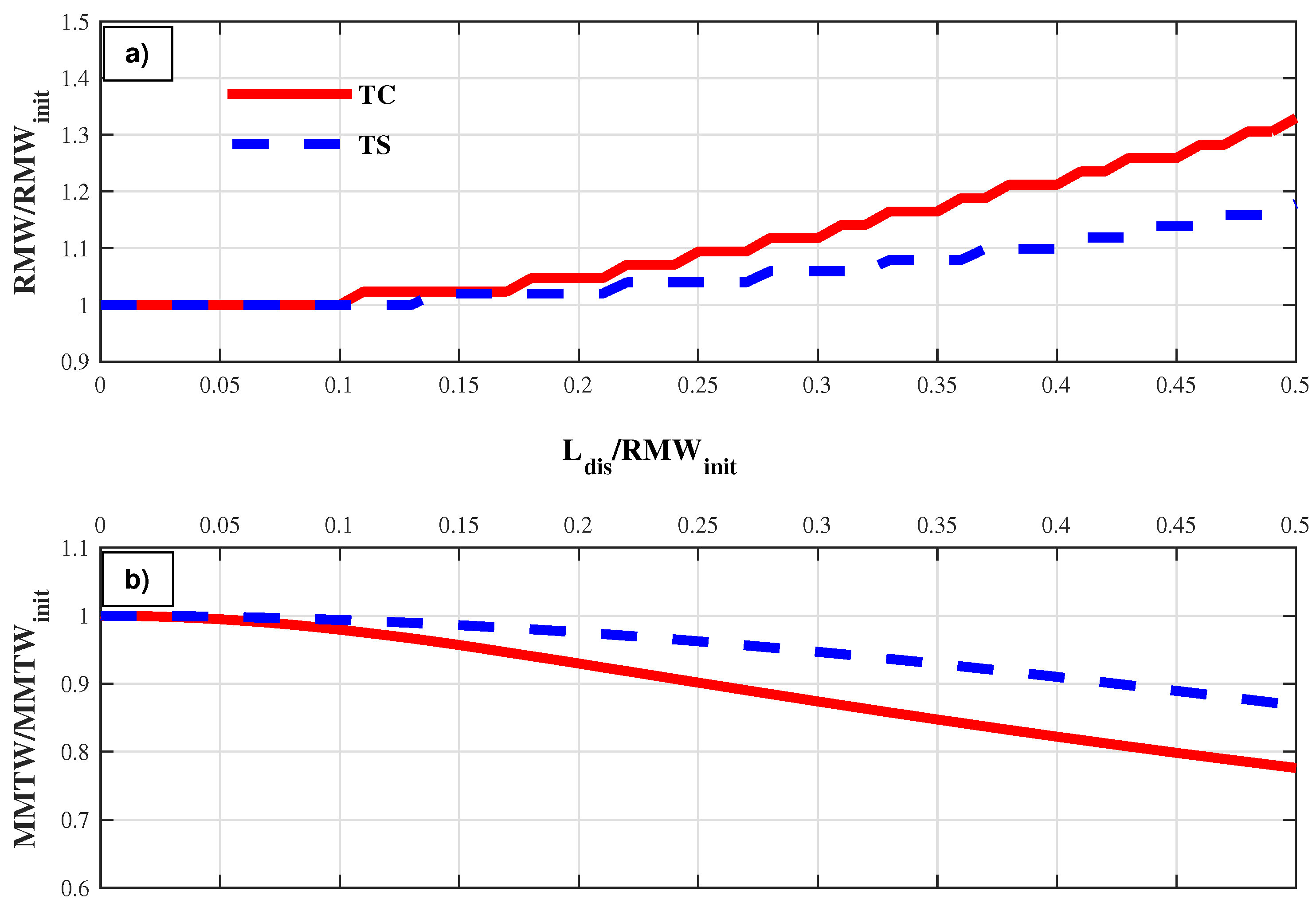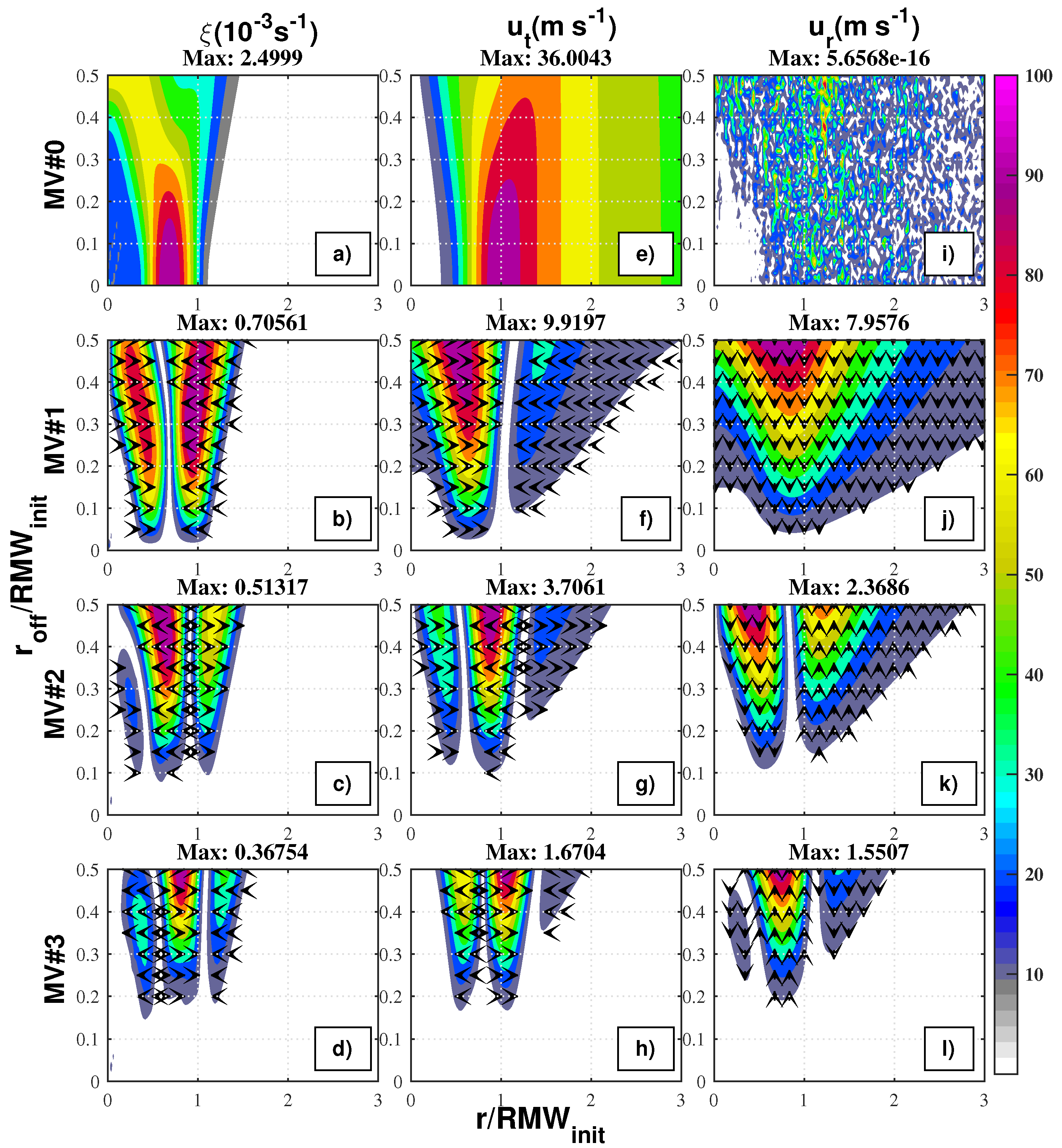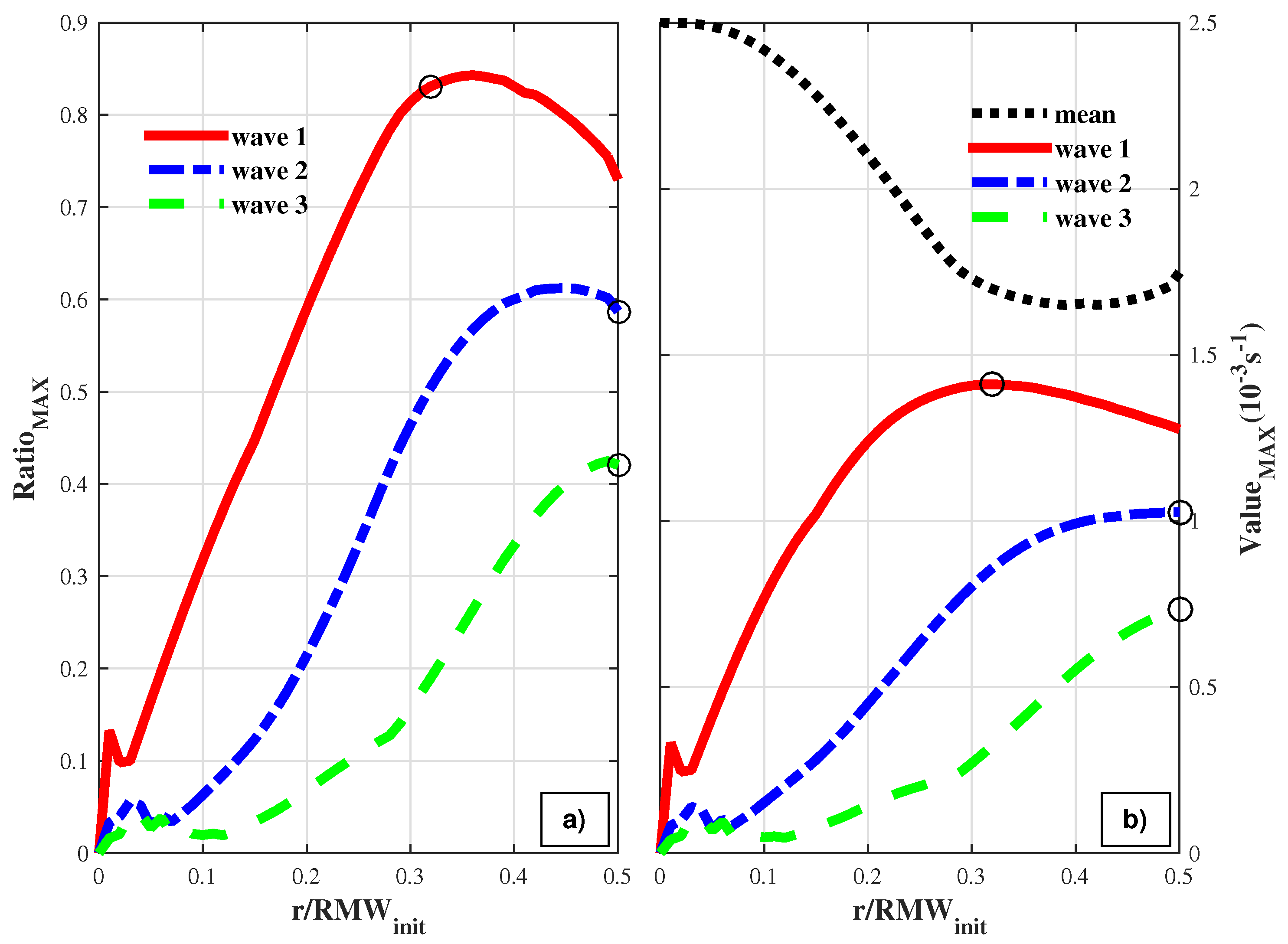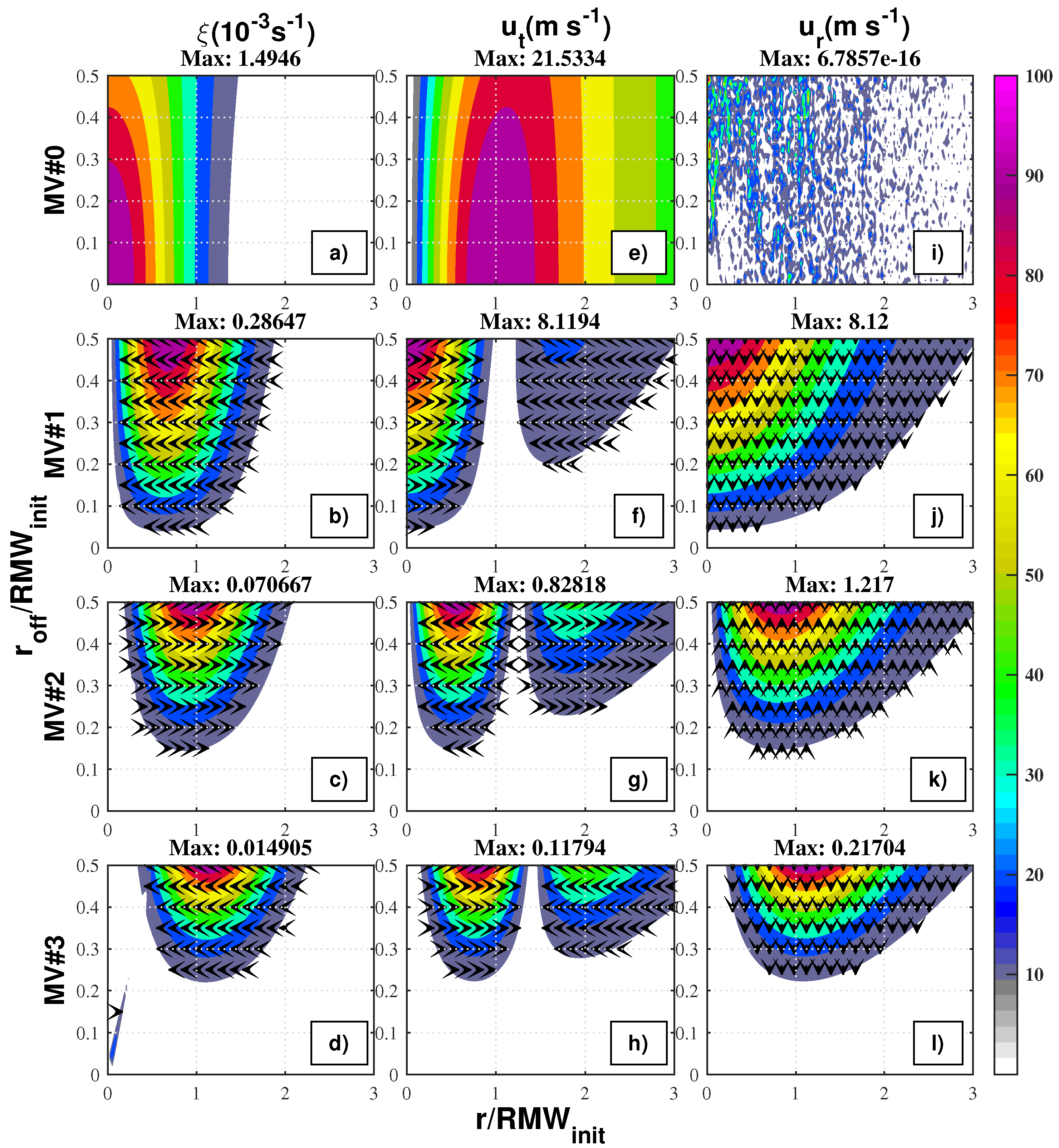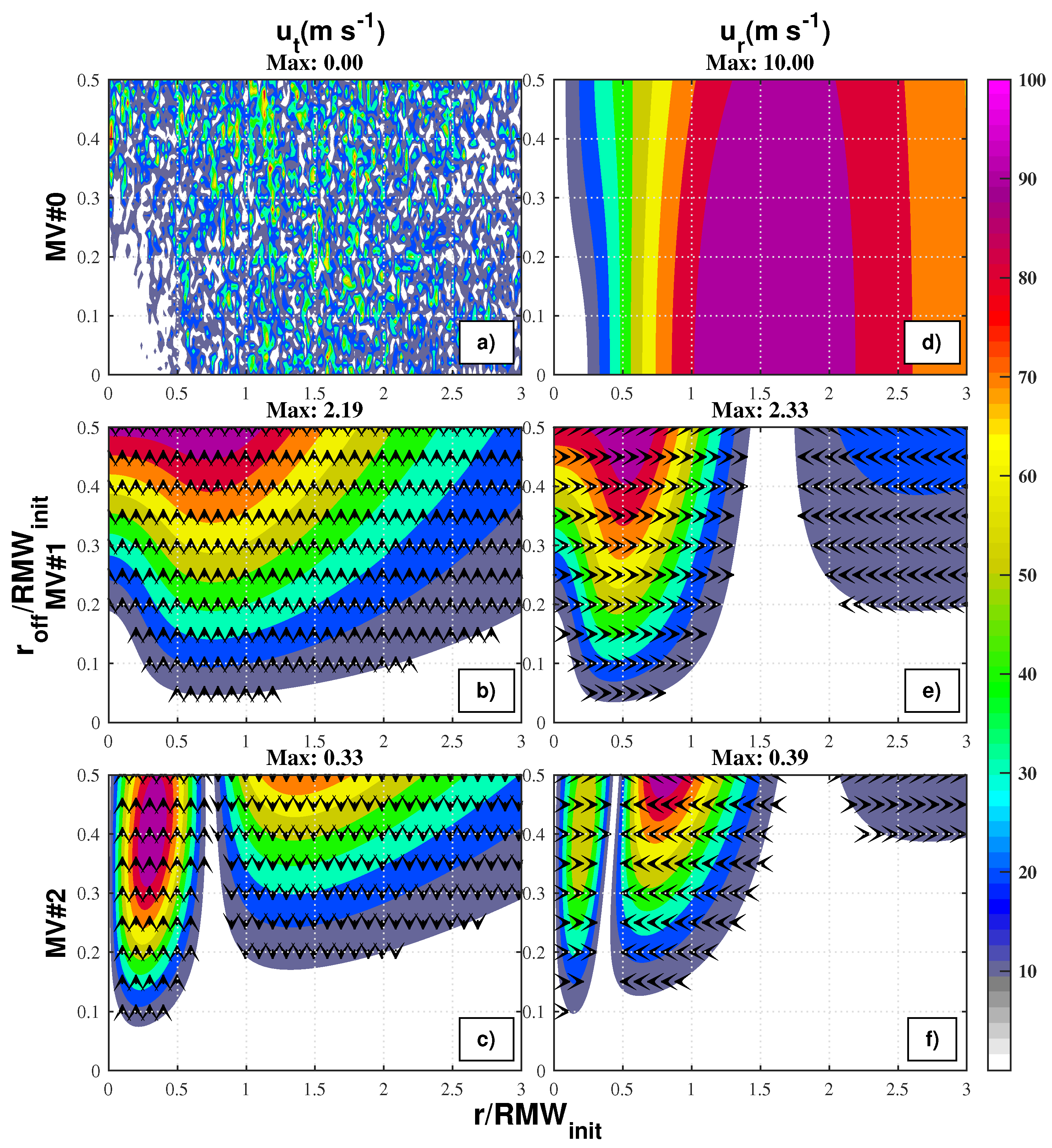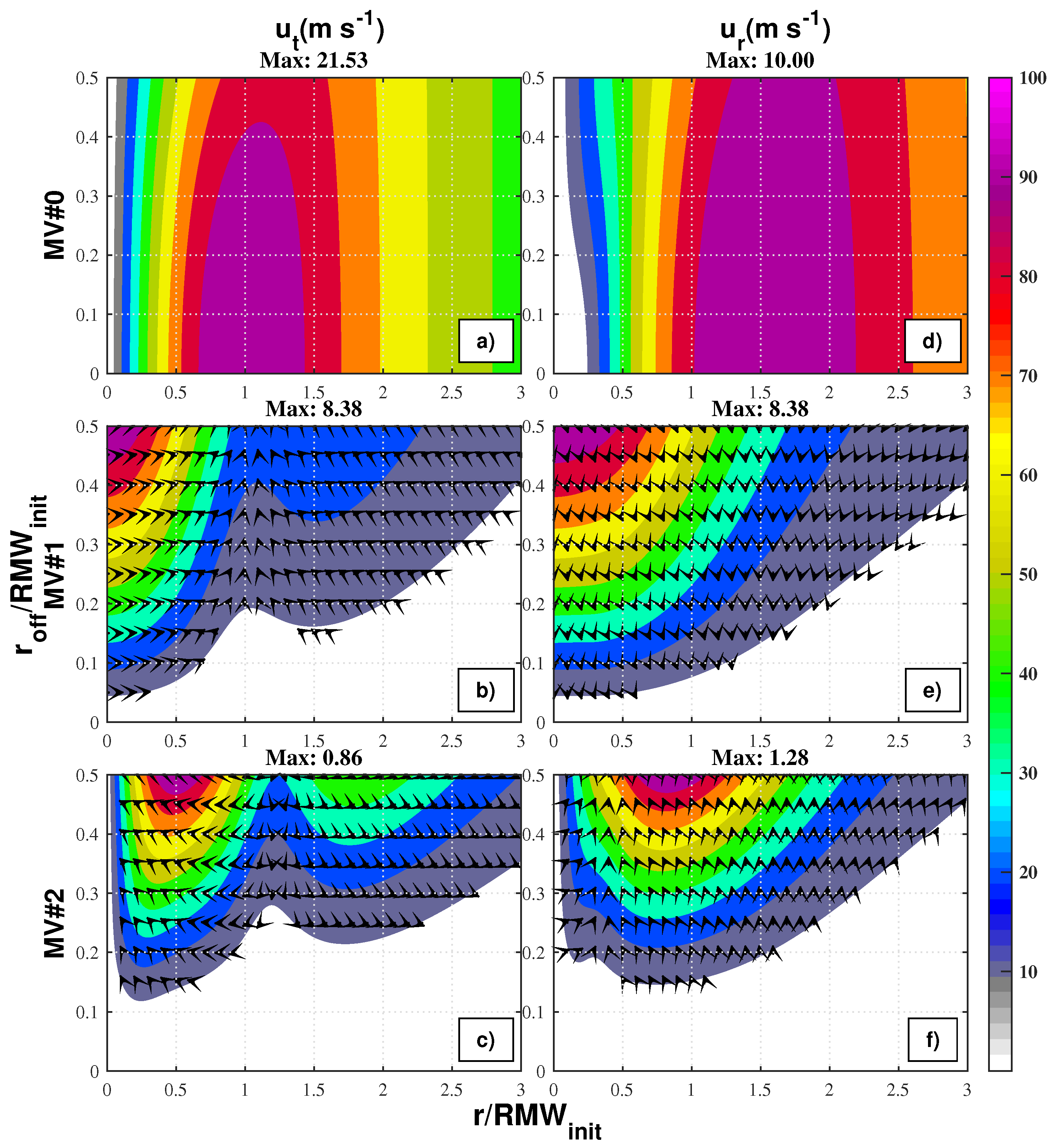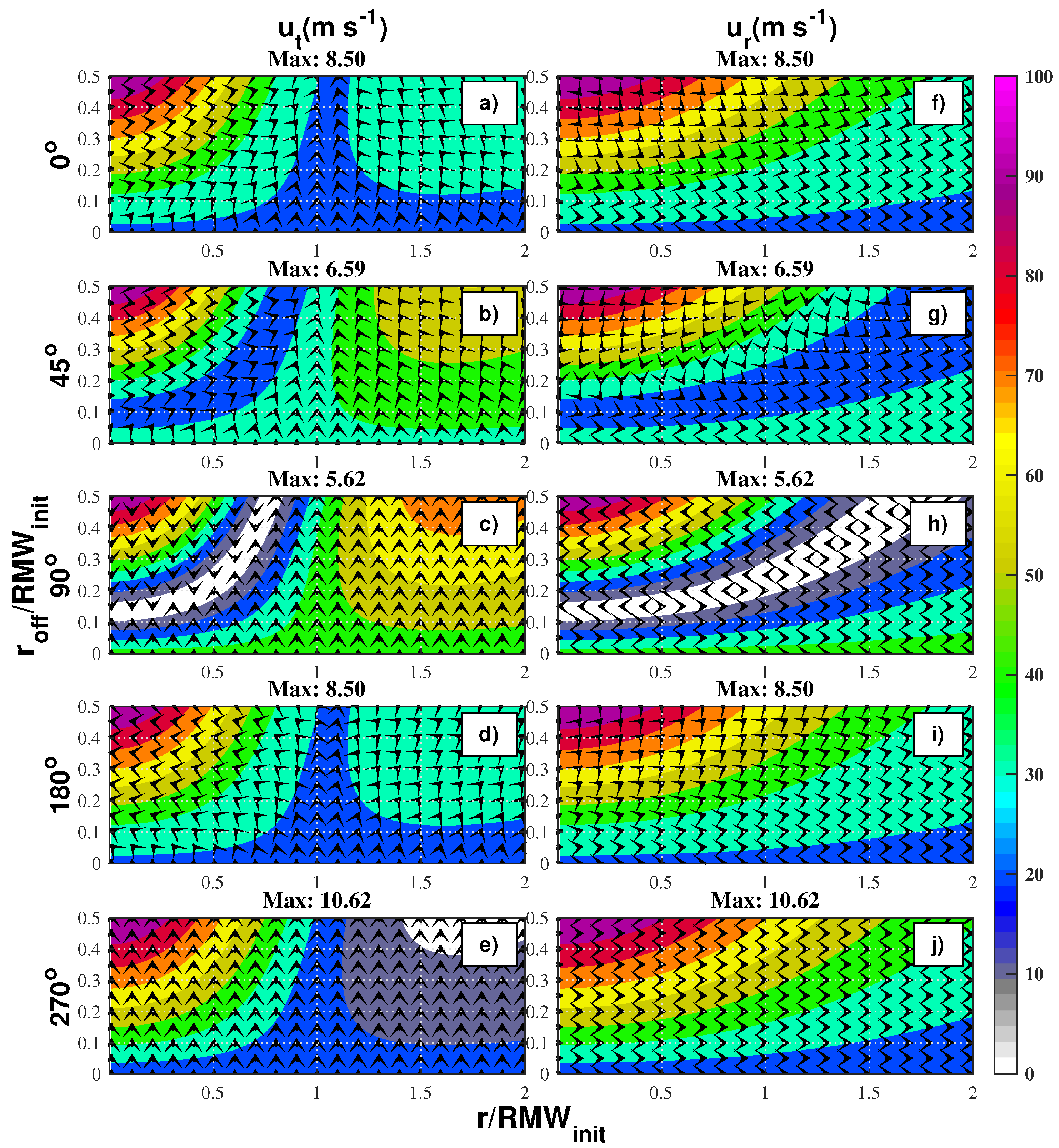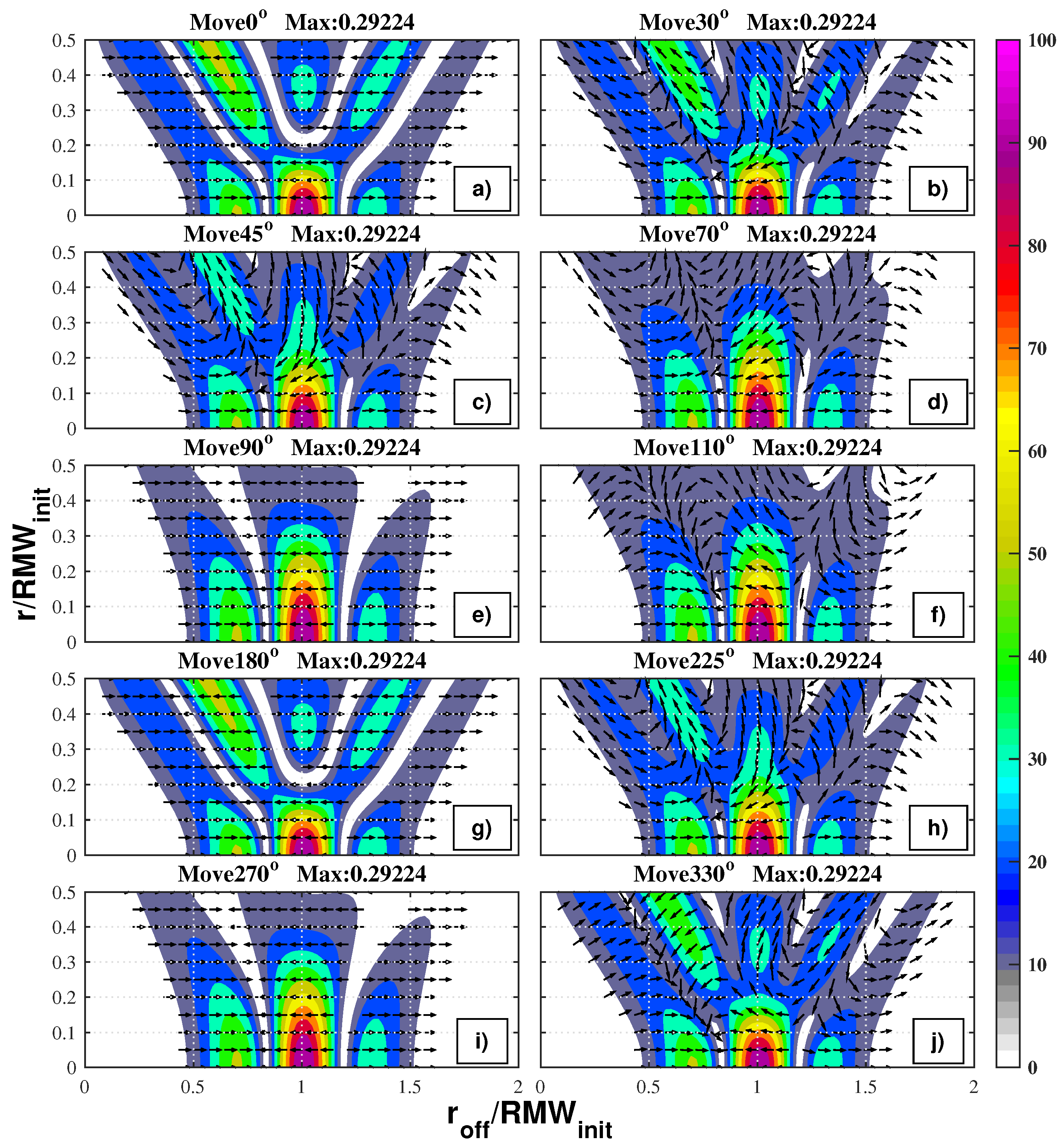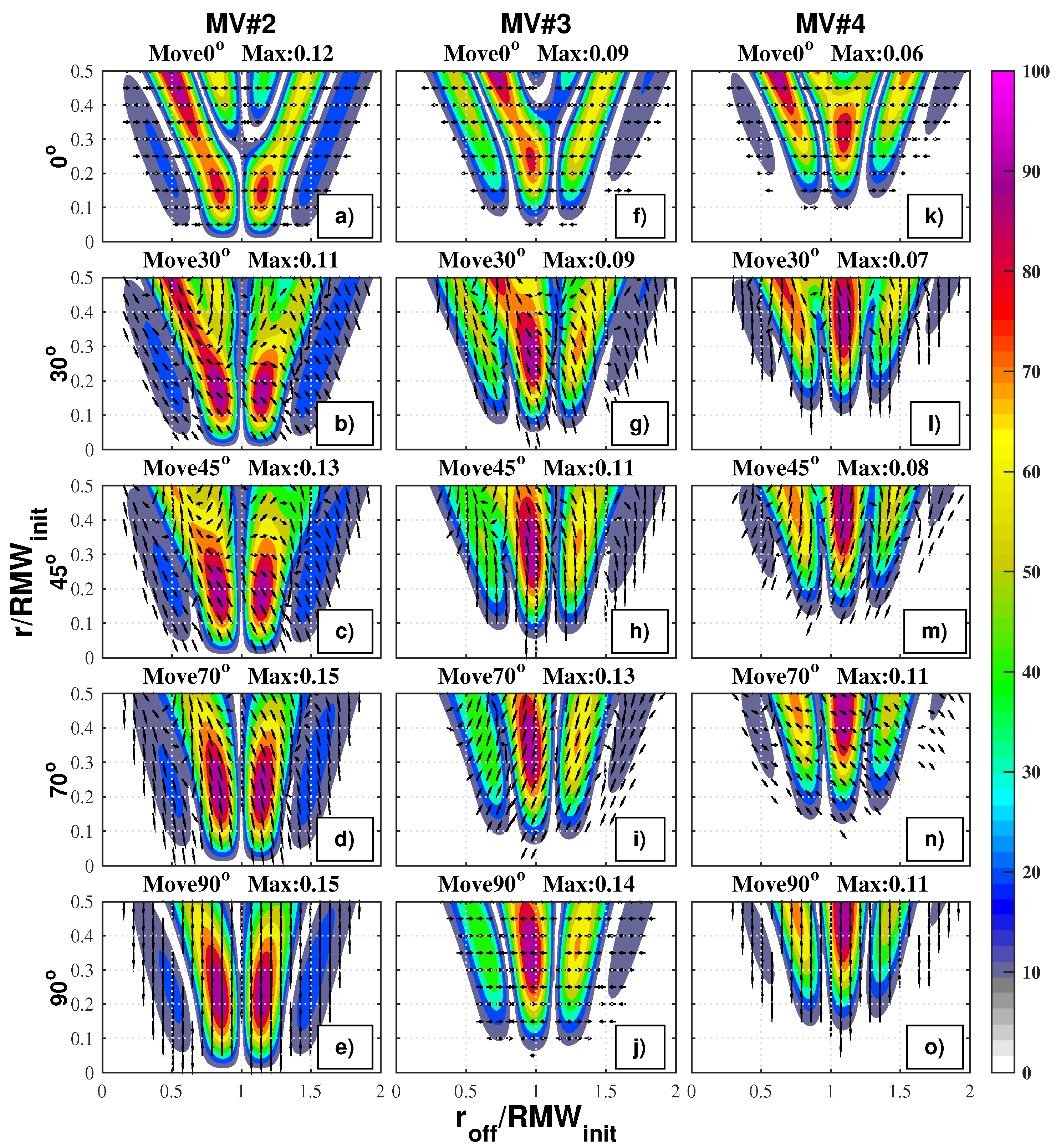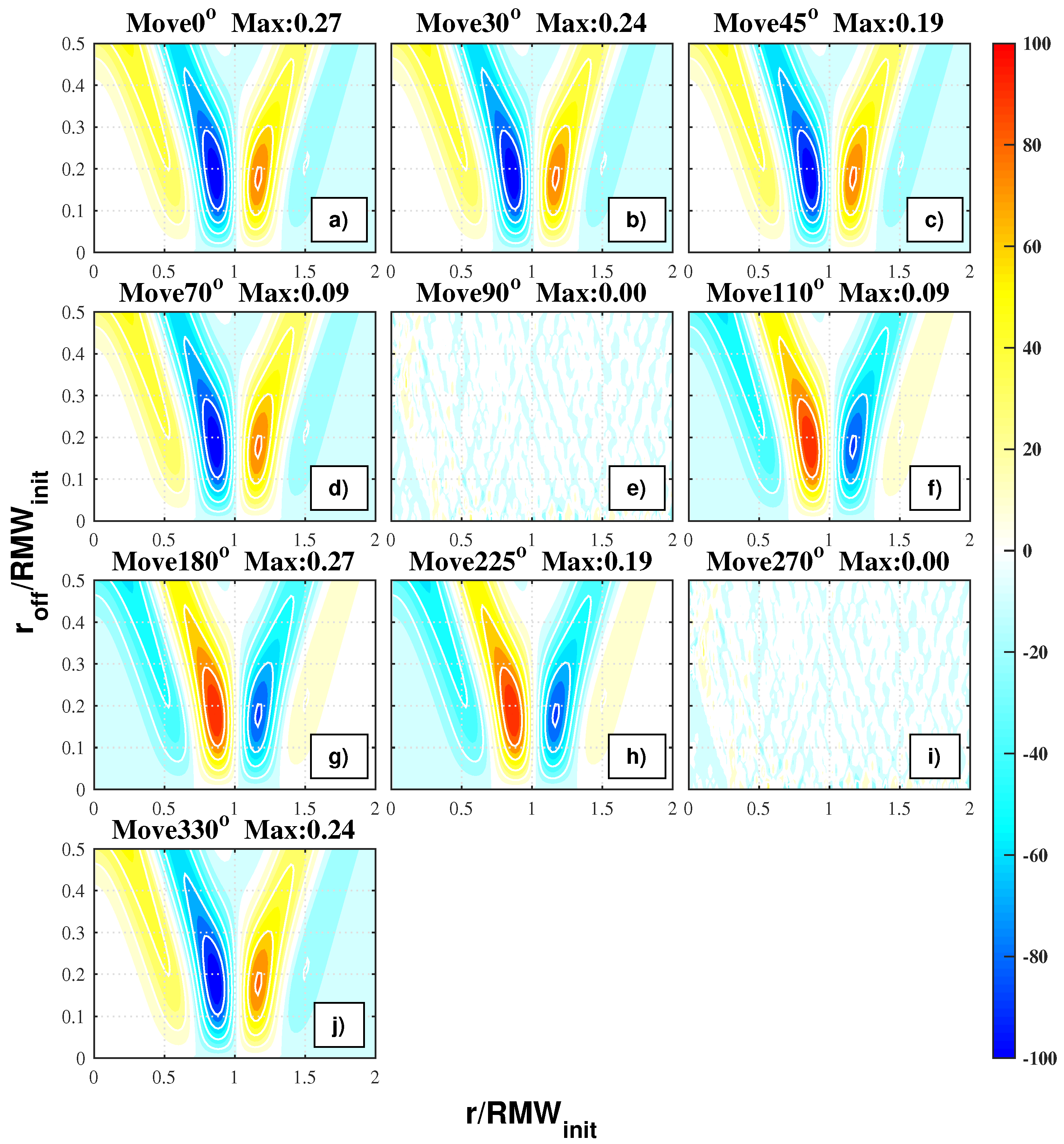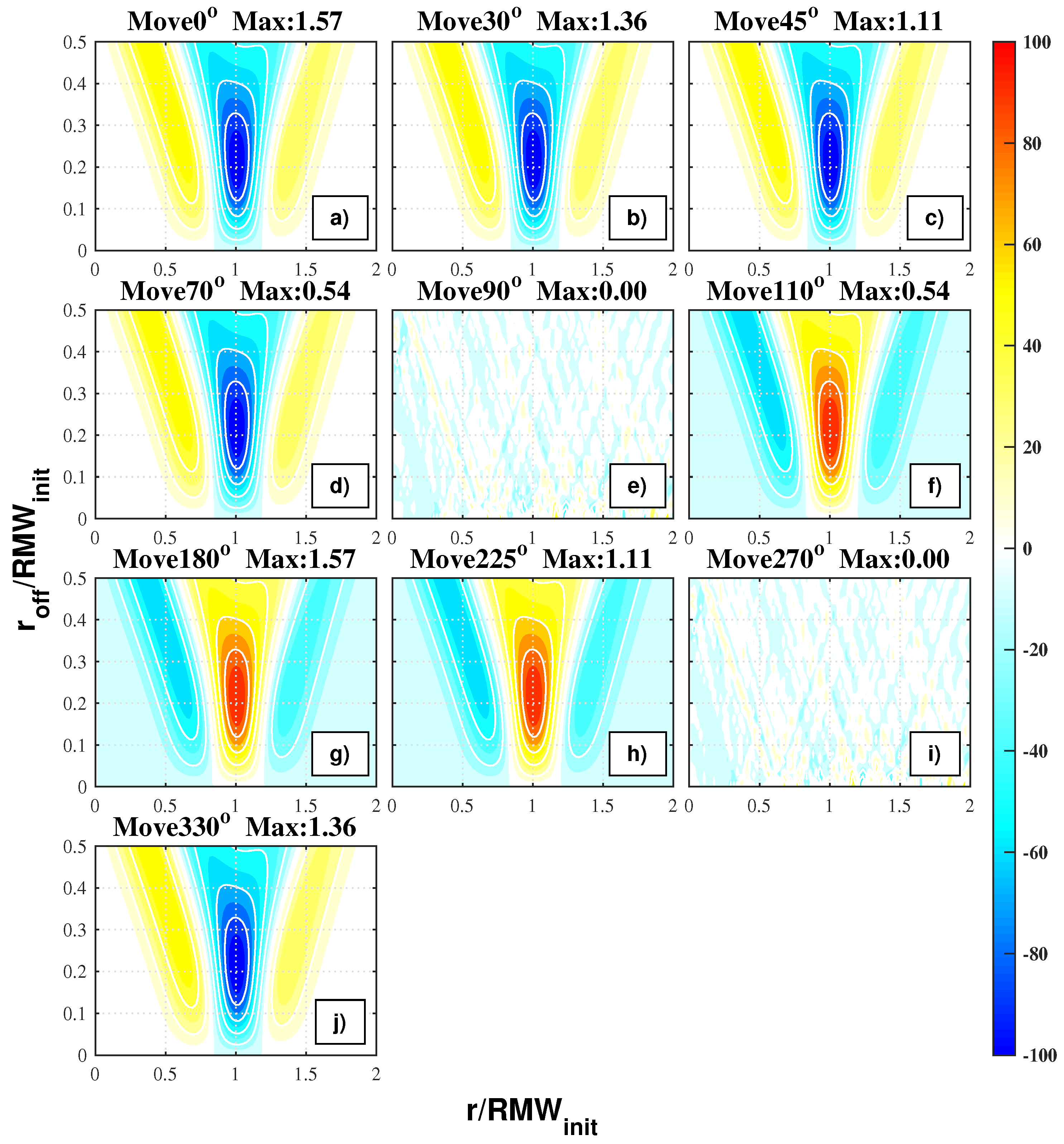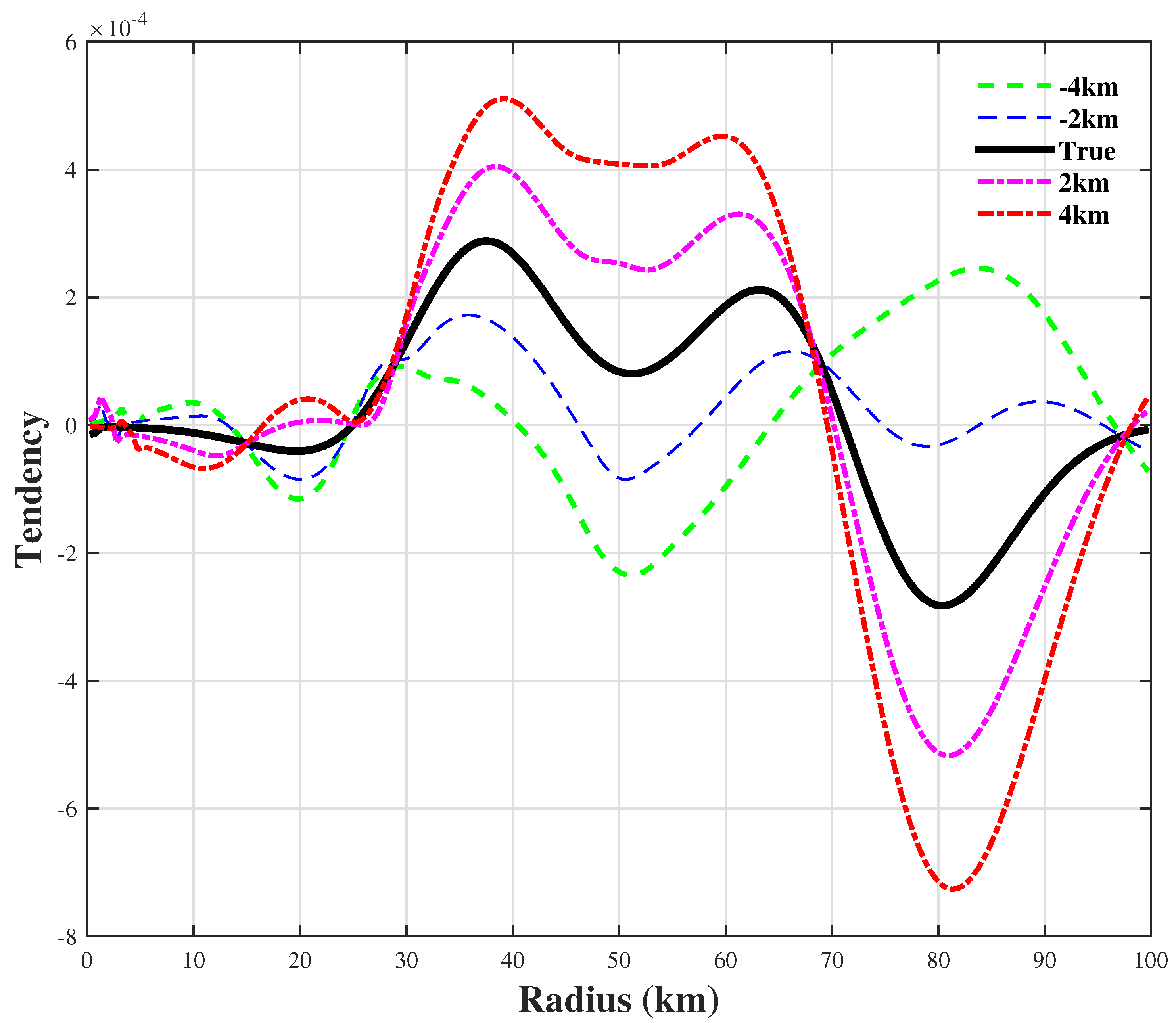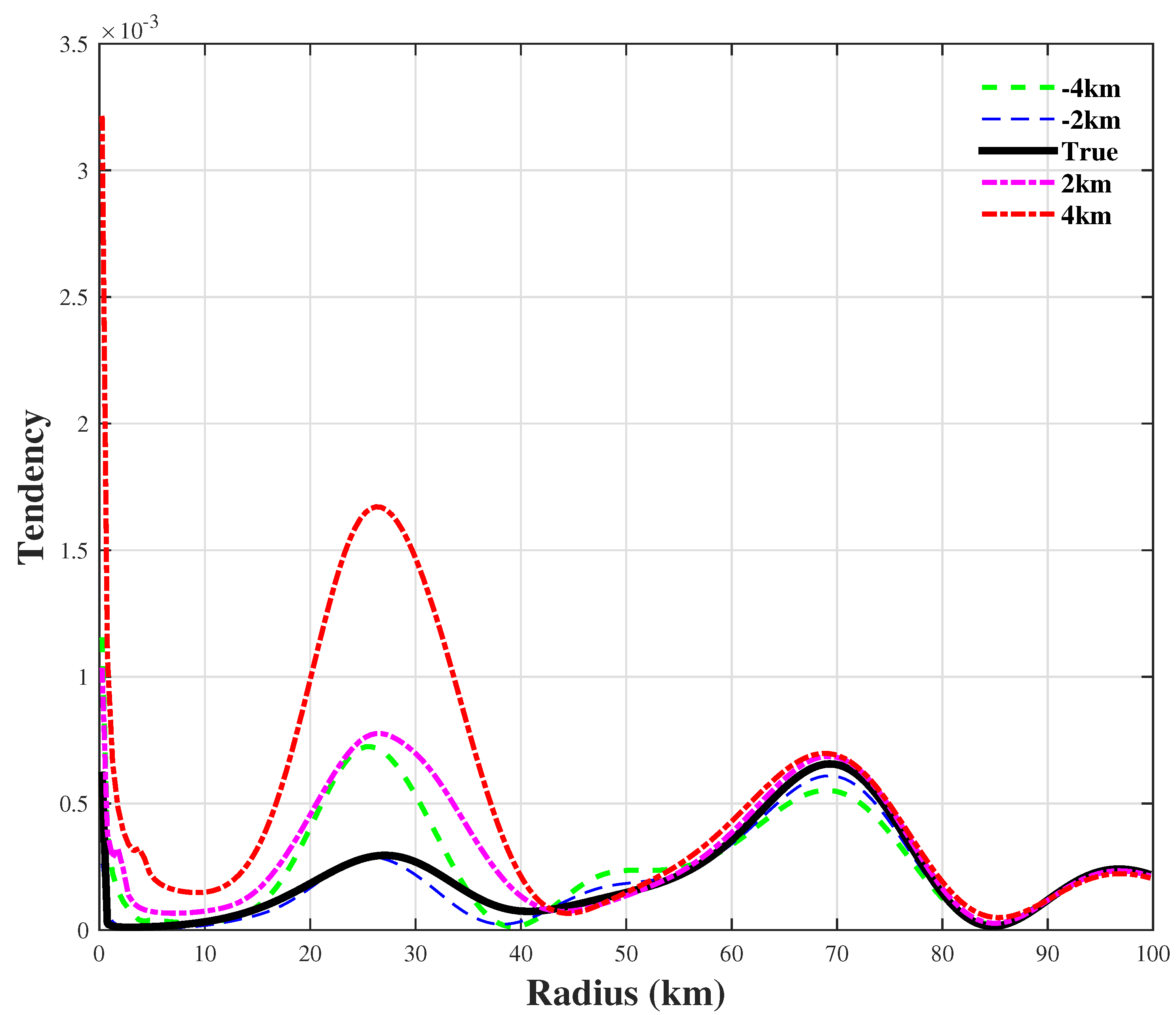3.1. Symmetric Tangential Wind
First and foremost, the basic behavior of an aliasing center on the primary circulation of a cyclonic vortex was analyzed by shifting the centers in the TC case and the TS case 0.5 RMW eastward.
Figure 4 illustrates the normalized changes of RMW and MMTW. In both the cases, the RMW expands as the center displacement increases, while the MMTW decreases. The decrease in MMTW is much more gradual than that in RMW, indicating that the MMTW is less sensitive to the center location, which is in agreement with the findings of Ry16. The normalized deviations in both RMW and MMTW are much smaller in the TS case, indicating that the displacement of thet center’s location has a larger effect on a hurricane-like vortex (mature typhoon) than on a storm-like vortex. Sensitivity tests on the resolution of the Cartesian grid were also carried out (not presented in this manuscript), and the conclusions remain the same. Moreover, the decrease of MMTW was much smoother than the expansion of RMW in a coarser Cartesian grid.
To further explore the aliasing asymmetries, the “postage stamp” presenting the normalized Fourier amplitude error profiles of vorticity, tangential wind, and radial wind used by Ry16 was updated by adding phase information to each radius. Phases at wavenumbers 1 to 3 are represented by black arrows. An eastward arrow indicates there is a positive wave peak located east of the original vortex. The phases are not displayed where the wave amplitude is less than 5% of the largest amplitude to emphasize the primal asymmetries. This new aliasing error profile is found to be a useful tool for illustrating the spatial distribution of asymmetries.
Figure 5 is the new “postage stamp” of the TC case. The symmetric mean vorticity is significant inside the RWM. The MMTW decreases and shifts outward, accompanied by the expansion of RMW with the increase in the offset. Meanwhile, the tangential wind at the inner radius increases gradually. These are in good agreement with the conclusions drawn from
Figure 4. The high-value center of the azimuthal mean vorticity tends to decrease in amplitude and shifts inward. The azimuthal mean radial wind exhibited artificial noise (on the order of 10
−16 m s
−1), indicating that it was not altered by the symmetric tangential wind with a center aliasing error. This noise feature in the symmetric radial wind is briefly explained by Equation (
A1) in the
Appendix A section.
Focused on the aliasing asymmetries of vorticity, aliasing error profiles at each wavenumber (
Figure 5b–d) were carefully examined. Two pieces of significant asymmetries were located, both on the inside of the RMW and at the inner radius of wavenumber 1 in
Figure 5b. The outer piece had a larger wave amplitude than the inner one at the same offset. As the potential center moved, the high-value centers at the inner and outer radii shifted inward and outward, respectively. This distribution of aliasing profiles at wavenumber 1 is called “dual lobes” in Ry16. For higher waves such as wavenumbers 2 and 3, there existed three high-value lobes along the radius with the maximum amplitude located at the middle.
Figure 6 illustrates the changes of the
and
with respect to the increasing center offsets. The maximum wave amplitudes (all 10
−3 s
−1) of an asymmetric vorticity at wavenumbers 1 to 3 are 1.41, 1.026, and 0.75 when the offset is 0.32, 0.5, and 0.5 RMW, respectively. The
of wavenumber 1 exceeds 0.8 at 0.3 RMW, and that of wavenumber 2 exceeds 0.5 at the same offset. This proves the aliasing asymmetries do play important roles in the vorticity fields. Moreover, the maximum value of wave amplitude at the wavenumber 1 vorticity decreases at a larger offset, while those at wavenumbers 2 and 3 increase. By extending the center offset to 1.0 RMW, the maximum amplitude at wavenumbers 2 and 3 are achieved at 0.56 RMW and 0.8 RMW, respectively. In other words, the asymmetries of vorticity at lower wavenumbers grow faster when the offset is small.
The spatial structures of aliasing vorticity asymmetries are also shown clearly in
Figure 5b–d, along with information on wave phases. There are only two phases (0° and 180°) in the aliasing profiles at wavenumbers 1 to 3. For example, there is a triple-lobe distribution of aliasing vorticity asymmetries at wavenumber 2 (in
Figure 5c). The wave phases are 0° at the inner lobe before turning to 180° at the middle lobe and reverting to 0° at the outer lobe. It is interesting to note that the phases remain constant in a single lobe and alter by 180 degrees between two adjoint lobes. In other words, the aliasing vorticity asymmetries encased by symmetric vorticity are non-tilting along the radius, and the positive and negative peaks are located in the same direction. It can also be concluded that the phases of aliasing vorticity asymmetries in the vorticity are parallel to the aliasing direction at any wavenumber.
The aliasing error profiles of wave amplitudes in both tangential and radial winds are similar to those in Figure 9 in Ry16 [
32]. Therefore, attention is paid to the radial structures of aliasing asymmetries. The phases of the tangential wind are parallel to the 0°–180° line at any given wavenumber and offset. The wave phases switch 180 degrees at the radius, where a minimum wave amplitude occurs. Meanwhile, the phases of radial wind are perpendicular to the line. In other words, the phases of aliasing radial wind are always parallel to the aliasing direction and perpendicular to those of the tangential wind. There is no tilting in the aliasing asymmetries of either tangential or radial winds as the wave phases maintain their direction within each lobe.
Based on the above discussions, it can be concluded that aliasing asymmetries of vorticity, tangential wind, and radial wind fields are highly sensitive to the aliasing direction in the TC case. The aliasing asymmetries induced by a symmetric vortex constructed by the tangential wind only are non-tilting along the radius, with positive and negative peaks located in the same direction.
Figure 7 is the new “postage stamp” of the TS case. Significant differences exist in the distribution of aliasing error profiles at low wavenumbers in the vorticity fields. The maximum value of the mean vorticity is always located at the center (
Figure 7a), except in the TC case where it shifts inward (
Figure 5a). There is only one lobe along the radius in the aliasing profiles of the vorticity at wavenumbers 1 to 3, except for the dual lobes in the TC case. The maximum amplitude at each wave increases monotonically with the offset, except at wavenumbers 1 and 2 in the TC case, where it decreases. Although the wavenumber-1 vorticity asymmetries are primal in the TS case, the aliasing asymmetries in the TC case are more significant at the same offset. For example, when the center displacement is 0.3 RMW in the TS case, the
at wavenumber 1 is 0.3, while being above 0.8 in the TC case. Therefore, the aliasing error of vorticity is less significant in terms of strength and simpler in radial structure in a storm-like vortex than in a mature hurricane.
It should also be noted that the phases of vorticity asymmetries in the TS case share similar characteristics with those in the TC case. By factoring in the tangential and the radial wind, asymmetry phases at each wavenumber that are parallel to the aliasing direction remain consistent within a single lobe and always turn 180 degrees at the boundaries of the lobes, indicating that the asymmetries are not tilted along the radius.
By considering the wave phases, the radial structures of aliasing asymmetries are carefully examined in this section. The most interesting findings are that the peak of aliasing vorticity asymmetries is parallel to the aliasing direction and that the aliasing asymmetries are non-tilting along the radius. As the discussions are based on an idealized symmetric vortex constructed by the tangential wind only, the symmetric radial wind alone will be addressed in the following subsection.
3.2. Symmetric Radial Wind
Although a strong symmetric radial flow is not relevant at the mid-levels of a mature cyclone, it is certainly important at lower and higher levels. The radial winds combined with vertical upward flows comprise the secondary circulation. First, the aliasing error profiles of a symmetric radial wind case (hereafter, IN) were illustrated. Then, the symmetric tangential wind of the TS case was added to analyze the aliasing asymmetries in a more realistic vortex (hereafter, TSIN). The initial profile of the symmetric radial wind was chosen by setting S to 150 km and to 10 m s−1.
Figure 8 illustrates the aliasing error profiles of the tangential and radial winds at low wavenumbers. The RMRW extends slowly as the center is offset, while the MMRW decreases (
Figure 8d). The azimuthal mean of radial wind at the inner core of the cyclone increases slightly at the same time. It stands to reason that the RMRW is slightly more sensitive to the aliasing center than the MMRW is because the RMW is more sensitive than the MMTW. The azimuthal mean tangential wind has a noise signature, indicating that the symmetric radial wind does not affect the symmetric tangential wind regardless of the center’s location.
In the aliasing profiles of the tangential and radial winds at low wavenumbers, the asymmetries expanded in radius and strengthened in wave amplitude as the aliasing distance increased. There are two primal asymmetries in the radial wind at wavenumber 1—the one inside the RMRW and the one weaker in strength and located on the outer radius. The dual-lobe distribution in this case is similar to that of the tangential wind at wavenumber 1 in the TC case. Meanwhile, the wavenumber-1 asymmetries of tangential wind seem to be a single-lobe distribution and extend further in radius than those of the radial wind. An explanation for the inconsistency of the extending radius of asymmetries of the radial wind through Equation (
A2) in both the TS and TC cases can be found in
Appendix A. The aliasing error profiles at other wavenumbers seem to be either dual-lobe or triple-lobe distributions.
The wave phases remain constant within a single lobe and switch 180 degrees at the boundaries. This non-tilting characteristics of the aliasing asymmetries are consistent with those in the former section. The phases of aliasing radial wind are parallel to the aliasing direction and perpendicular to the tangential wind at the same time. The amplitudes of both tangential and radial wind asymmetries at wavenumber 1 grow faster than those at other wavenumbers. Therefore, the symmetric winds are likely to produce aliasing perturbations at wavenumber 1 when the center is slightly displaced. Sensitivity tests on parameter S have also confirmed these findings.
Figure 9 illustrates the aliasing profiles of the TSIN case. The wave amplitudes in the tangential and radial winds (
Figure 9b,e) are not very different from those in the TS case (
Figure 7f,j). For example, the aliasing asymmetries of the tangential wind at wavenumber 1 reaches its maximum value (m s
−1) near 16.76 when the offset is 0.5 RMW, which is only 0.5 times greater than that in the TS case. The symmetric radial wind makes a limited contribution to the strength of the aliasing asymmetries in both the tangential and radial winds. It stands to reason that the tangential wind fields dominate the aliasing errors, as the symmetric tangential wind is much stronger than the radial wind. The phases of aliasing asymmetries within the lobes are parallel neither in the tangential wind nor in the radial wind. In other words, the aliasing asymmetries are tilted along the radius. For example, the aliasing tangential winds at wavenumber 1 are shifted anti-clockwise, especially when the center is slightly displaced. Moreover, the radial tilting of the tangential wind is more obvious than that of the radial wind. Therefore, besides having a less than significant impact on the wave amplitudes, the symmetric radial wind fields have a negligible influence on the radial structures of aliasing asymmetries.
3.3. Uniform Environment Flows
Environment flow is an important factor affecting the track and strength of TCs. The direction of convective asymmetries relative to environment flow was found to have a relationship with the intensity of a TC [
33,
34,
35]. In this section, the influence of a uniform flow on the aliasing error profiles is examined by adding constant flow to the TS case (hereafter, TSE). Ten aliasing angles were chosen to illustrate the influence of the aliasing direction. The uniform flow is set 2.5 m s
−1 eastward.
Figure 10 shows the aliasing error profiles of the TSE case in the tangential and radial wind fields in different aliasing directions. The aliasing direction affects the maximum wave amplitude of aliasing asymmetries. The aliasing wave amplitudes in both the radial and tangential wind fields increase to 2.5 m s
−1, which equals the strength of environment flow when the aliasing direction is 270°. Meanwhile, the largest negative influence (−2.5 m s
−1) is achieved once the aliasing direction is at 90°, compared to
Figure 7f,j. The aliasing wave amplitudes of tangential and radial wind in the 0° case (
Figure 10a,f) are identical to those in the 180° case (
Figure 10d,i). Once the aliasing direction approaches 90°, the negative influence on the wave amplitude of aliasing asymmetries increases. This is in contrast to the case when the aliasing direction approaches 270°. The differences in aliasing asymmetries are more pronounced in their radial structures. For example, despite the wave amplitudes of the tangential wind in the 0° case being identical to those in the 180° case, a remarkable difference exits in the wave phases. The asymmetries of tangential wind in the 0° case have an anti-clockwise tilt. Meanwhile, those in the 180° case have a clockwise tilt. The aliasing error profile can be determined by the symmetric tangential wind with a certain aliasing direction and constant appendages induced by uniform flow.
Thus, it is confirmed that the aliasing error profiles are sensitive to the strength of uniform flow. However, it should be noted that the aliasing asymmetries are determined not only by the distribution of symmetric wind but also by the strength of the environment flow and the aliasing direction.
3.4. Isolated Asymmetries
Multi-scale convective systems embedded in the tropical cyclone circulations are represented by the azimuthal waves. As strength and radial structures are important for evaluating the wave–mean interactions, the aliasing error profiles of the asymmetries were investigated carefully. The symmetric tangential wind was removed after adding the initial asymmetries to isolate said asymmetries from other circulation systems. Therefore, only the vorticity and winds related to the initial asymmetries were kept in the Cartesian grid. According to Ry16, the aliasing error profiles are the same whether the aliasing direction is away from or close to the maximum of the asymmetric center. Once the center has moved along the zero contour of the asymmetries, the aliasing error profiles take on a different distribution. For a full understanding of the influence of aliasing direction, sensitivity tests were performed with a larger group of aliasing directions. More focus was given to the radial structure and the dispersion of wave energy.
Figure 11 shows the initialization of wavenumber 1 asymmetries centered at the RMW of the TC case (hereafter AS1). The vorticity is shaded and normalized with the maximum value (0.28 × 10
−3 s
−1). The divergence at each grid point is zero because the asymmetries are defined in streamfunctions. Therefore, the maximum positive and negative vorticity centers are surrounded by nondivergent flows. Similar distributions can be observed in the vorticity and wind fields initialized at a higher wavenumber but with more positive and negative centers located along the azimuthal direction. Ten different directions were artificially chosen for the wavenumber-1 asymmetries. The 0° and 180° angles indicate that the offsets were moved toward the positive and negative centers (peak line), respectively. Moreover, the 90° and 270° angles represent that centers moved along the zero contour of the vorticity field (middle-line) but in different directions. Other aliasing directions such as 30°, 45°, and 70° were chosen to represent a gradual change between a middle line and a center line. These directions were chosen based on their symmetric characteristics. For example, 70° and 110° are symmetric to the middle line. The aliasing directions at other wavenumbers were chosen in the same way.
Figure 12 illustrates the aliasing error profiles of the vorticity at wavenumber 1 in different aliasing directions. The most noticeable feature is that, although the amplitudes of asymmetries decrease, the radial positions remain unchanged when the offset is less than 0.2 RMW. Meanwhile, there is a large inconsistency between different aliasing directions, especially at larger offsets in terms of the amplitude and phase.
The aliasing profile appears to be a triple-lobe distribution when the center has moved along a peak line (0° or 180°) and when the offset is less than 0.2 RMW. The strength of the wave amplitude decreases with the increase in the offset. The lobe in the middle trifurcates into three lobes, and the maximum value of the wave amplitude increases again with a growing offset (
Figure 12a,g). Meanwhile, once the aliasing centers are on the middle line, the aliasing profile becomes a triple-lobe distribution (
Figure 12e,i). The wave amplitude on the middle line decreases monotonically except when it experiences a regrowth in the peak line case. In agreement with the findings of Ry16, a large difference is seen in the wave amplitude of the aliasing profiles between the middle line case and the peak line case. With a focus on the radial structures of asymmetries, it is interesting to find out that there was no radial tilt within any single lobe once the center had moved along the middle line or the peak line (
Figure 12a,e,g,i). The wave phases always turn 180 degrees at the boundaries. Therefore, not only the strength but also the radial structures of the aliasing asymmetries are identical once the two offsets are along the middle line or the peak line at the same displacement. It was also confirmed that the information loss in the initial asymmetries was more gradual when the aliasing direction was along the middle line than along the peak line.
The aliasing error profiles of wave amplitudes gradually shifted from the middle-line case to the center-line case once the center moved in the other directions. For instance, the distribution of wave amplitude in the 30° case (
Figure 12b) was more similar to that in the 0° case (
Figure 12a) than in the 90° case (
Figure 12e). The aliasing error profiles were found to be identical in amplitude when the aliasing directions were symmetrical to a middle line (such as
Figure 12d,f) or a center line (such as
Figure 12b,j). The asymmetries in the radius were always tilted. Despite the wave amplitudes between the symmetric cases being identical, there was a significant difference in the tilting directions. For example, the inner lobe in
Figure 12d has an anti-clockwise tilt, whereas, in
Figure 12f, it has a clockwise tilt. In other words, the spatial structures of the aliasing vorticity asymmetries were more sensitive to the aliasing direction but not their strength.
Figure 13 illustrates the mechanism of aliasing of initial wave onto other wavenumbers in different aliasing directions. Only parts of the cases are displayed to illustrate the sensitivity of wave dispersion to the aliasing direction because of the symmetric characteristics of the aliasing error profiles between two symmetric aliasing directions. The aliasing error profiles appear to be a cluster of lobes along the radius, extending outward or inward with the increase in offset. A large distinction lies in the aliasing profiles between a center-line (0°) case and a middle-line (90°) case at each wavenumber. The aliasing profiles in other directions also show a gradual transformation from the center-line case to the middle-line case.
The radial tilting of aliasing asymmetries is much more complex. For example, in the 30° case, there is an anti-clockwise tilt in the inner-most lobe and a clockwise tilt in the lobe inside the 1.0 RMW at wavenumber 2 (
Figure 13b). Meanwhile, the tilt in the inner-most lobe is clockwise and becomes anti-clockwise in the outer lobe at wavenumber 3 (
Figure 13g). However, there is no radial tilting within any lobe when the offset is along a middle-line (
Figure 13e,j,o) or a peak-line (
Figure 13a,f,k). Through a deeper exploration of the aliasing profiles, some symmetric characteristics were also discovered. The aliasing error profiles at wavenumbers 2 and 4 shared similar characteristics, different from those at wavenumber 3. Firstly, the phases at wavenumber 3 were parallel to those of the initial wavenumber 1 asymmetries when the center moved along the center line or middle line. The aliasing asymmetric phases were symmetric to the peak line of the initial asymmetries when two aliasing directions were symmetric to a center line or a middle line (not shown here). Secondly, for aliasing profiles at wavenumbers 2 and 4, the phases were perpendicular and parallel to initial phases when the aliasing directions were along a middle-line and a center-line, respectively. When two aliasing directions were symmetric to a middle-line or a peak-line, the aliasing phases were symmetric to the line as well.
For the aliasing error profiles of initial asymmetries at other wavenumbers, not only the wave amplitude but also the phases of the aliasing vorticity asymmetries satisfied all the symmetric characteristics discussed above. As there existed more than one peak along the azimuthal direction, neither the directions toward the positive and negative centers nor those along different middle lines were parallel. Therefore, the symmetric characteristics became stricter. Firstly, the phases were parallel along the radius when the offset was along a center-line or a middle-line, indicating that the aliasing vorticity asymmetries were not tilted. Meanwhile, the aliasing asymmetries were tilted along the radius in other directions. Secondly, the aliasing phases were symmetric to a peak line when the aliasing directions were symmetric to the line. If two aliasing directions were symmetric to a line perpendicular to a peak line, their wave phases were symmetric to the line as well.
The dispersion of wave energy is discussed because of its importance in the energy spectrum.
Figure 14 shows the AWER of the AS1 case for different aliasing directions. It should be noted that the symmetric characteristics in the wave amplitude are reflected in the wave energy at each wavenumber, as is the gradual transformation of aliasing asymmetries in the vorticity. The wave energy decreases rapidly before the center is moved further than 0.2 RMW in the 0° and 180° cases at the initial wavenumber 1. Therefore, the energy loss is the greatest along the peak lines, which is consistent with the previous findings of the authors of this paper. The wave energy in the peak-line case increases after the trifurcation occurs. Meanwhile, the loss of wave energy appears to be a continuous attenuation in the middle-line cases. Even though the peak-line cases conserve more wave energy at the initial wavenumber, the radial structures of asymmetries have been completely aliased according to
Figure 12a. At other wavenumbers, it is clear that more amounts of wave energy are distributed when the aliasing direction is along a middle line, especially when the displacement is small. For instance, the energy at wavenumber 2 in the middle-line cases is nearly twice that in the peak-line cases when the offset is at 0.25 RMW. The wave energy at wavenumber 2 appears to have gained more energy for the initial wavenumber 1 asymmetries than for other wavenumbers. The higher the wavenumber, the lower the aliasing wave energy gain.
The standard dispersion—defined as the ratio of the maximum difference between the AWER values among different directions and their mean value—were used to evaluate the potential dispersion of wave energy at each wavenumber. The standard dispersion shows that the dispersion of aliasing wave energy is smaller at larger wavenumbers. For example, when the center is erroneously positioned 0.2 RMW away, the standard dispersions are 0.82, 0.68, 0.47, and 0.35 for wavenumbers 1 to 4, respectively. After examining the error profiles from the asymmetries at other initial wavenumbers (not shown here), the aliasing error profiles for higher waves seem to be insensitive to the aliasing directions. The aliasing center prefers to distribute the wave energy to the adjoint wavenumbers, and the aliasing asymmetries at a smaller wavenumber gain slightly more energy.
Last but not the least, how the aliasing asymmetries affect the mean fields when the center is erroneously positioned is discussed.
Figure 15 shows the aliasing errors in the azimuthal mean vorticity fields in different aliasing directions of the AS1 case. The changes appear to be pairs of positive and negative peaks around the radius where the maximum amplitude of the initial asymmetries is located. The influence at the inner side is slightly stronger than that at the outer radius. The signs are opposite despite the absolute changes being identical when the aliasing directions are symmetric to a middle line (
Figure 15a,g). Meanwhile, the displacement of the center’s location would not change the mean vorticity fields when the center is along a middle line (
Figure 15e,i). Moreover, when the aliasing directions are symmetric to a peak line, their changes to the mean vorticity field are identical. The maximum change of mean vorticity occurs when the center is moved along a peak line, as the loss of wave energy at the initial wavenumber is the largest. Therefore, asymmetries do affect the mean vorticity, and their influences are sensitive to the aliasing direction.
Figure 15 and
Figure 16 are similar to each other except for the changes in the mean tangential wind fields. The mean tangential wind can be reduced or increased at the radius where most of the asymmetries are located. The changes at both sides of this maximum center are weaker and have the opposite signs. Similar symmetric characteristics in different aliasing directions are also found in the upscale influence on the mean tangential and radial winds fields as well (not shown here). The azimuthal mean fields can also be altered when an aliasing error is induced by the asymmetries at higher wavenumbers. Thus, the upscale influence decreases as the initial wavenumber increases. Therefore, it should be noted that aliasing asymmetries do influence the mean fields when the center is displaced. Moreover, the aliasing asymmetries could induce an error in the MAV algorithm as their convergence condition is to maximize the mean tangential wind once the asymmetries around the RMW become significant.
Sensitivity tests on the strength, location, and radial size of the initialized asymmetries were also performed. It was found that the radial size and strength of the initial asymmetries determined the radial distribution of the aliasing error profiles and controlled the absolute amplitude, respectively. The location of the center location of the asymmetries is an important parameter that decides the range of influence induced by the aliasing asymmetries.
3.5. Sensitivity Tests of Angular Momentum Equations
The increase in the azimuthal tangential wind at the RMW is considered the intensification of a tropical cyclone. Many scholars have used the tangential wind tendency equations to illustrate the key factor that dominates the intensification process. Sensitivity tests on the angular momentum equations were carried out using the TCA constructed in
Section 2. The order of each tendency terms in Equation (
7) is approximately (10
−3 m s
−2), except for the MRT and ART terms. The MCT term in the azimuthal mean radial wind equation is more significant. Meanwhile, the ART term dominates Equation (
6) at an order of 10
−4 m s
−2. Terms including
are negligible because the initial condition is set without any symmetric radial wind.
Focused on the wave–mean interaction terms in the tangential wind equation, the radial distributions of the ART are displayed in
Figure 17. The ART has a small negative value at the inner radius. It has a positive influence over the range of 25 km to 70 km and a negative influence at the outer radius. This S shape of the ART is centered at 70 km, where the strongest asymmetries are located, according to
Figure 3. The range of positive tendency fluctuates due to the existence of weaker asymmetries. In other words, there was a slight contraction and intensification of the azimuthal mean wind by the idealized asymmetries. Thus, the ART was doubled when the center was located 4 km to the west, indicating an overestimation of asymmetries. However, the influence of ART could be completely reversed when the offset was only 4 km to the east. The dominant “S” shape, which was centered at 70 km, has a negative influence at the inner radius and a positive influence at the outer radius, which represents the weakening and expansion of the tangential wind. The aliasing error in the ART becomes larger in magnitude with as the center displacement increases. Opposite wave–mean interactions can also be found in the radial profiles of the ACT term. Therefore, it is extremely important to know that the analysis on the wave–mean interaction is highly sensitive to the location of the center, especially to the aliasing direction relative to the true center.
Figure 18 shows the ACT in Equation (
7). The initial asymmetries tend to increase the azimuthal mean radial wind. The positive influence by the dominant asymmetries centered at 70 km is more significant than the weaker asymmetries at the inner radius. The ACT at the outer radius is insensitive to the center location, leading to the conclusion that the radial structures of initial asymmetries could be preserved at a small displacement in the former section. Meanwhile, the ACT is altered severely at the inner radius. The positive tendency is doubled once the center is located only 2 km eastward. The aliasing error in the ACT also increases with the increase of the center displacement. Therefore, the ACT term is sensitive to the aliasing direction. Compared with the reversed contributions of the asymmetric flows in Equation (
6), the contributions of the ACT term in Equation (
7) are less sensitive to the location of the center. Moreover, the radial distributions of the other terms in Equation (
7) change insignificantly in different aliasing directions, especially the MCF and MCT terms. Therefore, it can be concluded that the diagnosis of azimuthal mean radial wind is less sensitive to the location of the center and that the wave–mean interactions on the radial wind terms are more reliable than those on the tangential wind.
Although the conclusions are based on idealized experiments, they explain the disagreement on the role of asymmetric flows. A further verification of the robustness of related conclusions with the understanding of uncertainties in the diagnostic equations is needed.
